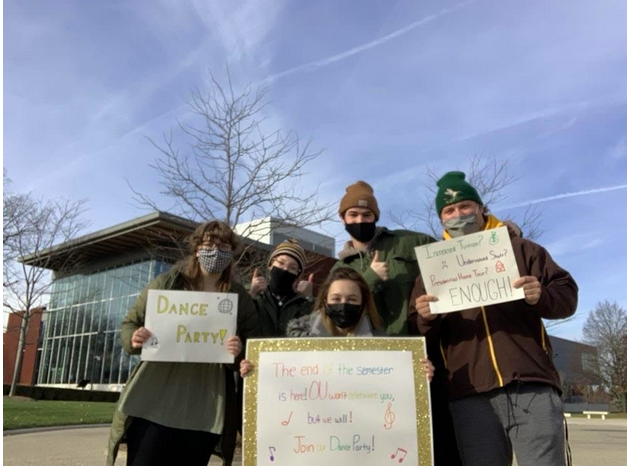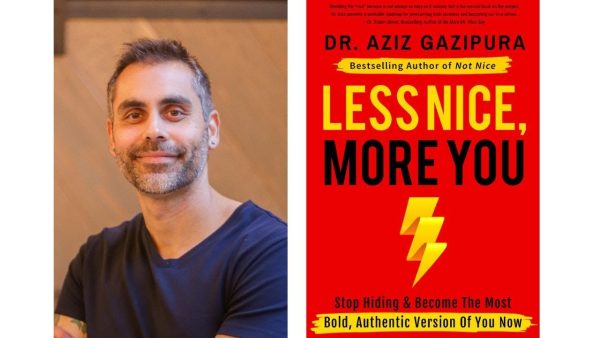OU students turn dance party into protest
Recent OU alumna, Jenna Amore, and four other students gathered on Nov. 22 around Elliott Clock Tower to celebrate student accomplishments while protesting OU administration.
On Nov. 24 as Elliott Clock Tower struck 1 p.m., five students gathered around for a dance party. Approaching the end of the semester, then senior, Jenna Amore, organized the dance party as a celebration of student accomplishments during another semester in a pandemic.
Amore and her peers also used the dance party as an opportunity to protest the administration’s lack of recognition for the exhausting semester that, once again, students persevered through.
She arranged the dance party as part of an end-of-the-year assignment for her senior thesis class — “Love and Political Violence.” The assignment prompted students to be part of the community and fight for something that they believed in. Amore, also feeling the burden of another difficult semester, decided she wanted her project to be both a celebration and a protest.
“I thought these students have had such a hard semester and nobody is really taking notice, so I wanted to have this dance party to celebrate that, but I kind of turned it into something a little more political,” she said. “I realized our university is not really doing a whole lot to celebrate us as students and it seems that they’re flaunting all these new projects and expensive stuff and they’re not prioritizing their students. I kind of arranged the dance party so it could be somewhat of a protest against the administration and how they’re not really prioritizing their students.”
The protest also featured signs saying, “The end of the semester is here! OU won’t celebrate you but we will! Join our dance party!”and “Increased tuition? Undervalued staff? Presidential House Tour? Enough!”
Amore, being a writer for StudyBreaks Magazine, took to her platform to write an article about her project and how dance itself is used as a form of protest. In her article, she notes how dance connects diverse communities and offers a medium of expression that replaces the need for words and emphasizes action.
Amore also says in her article, dance as a form of protest has a long history and has seemingly grown in popularity, as seen in recent movements: Jo’Artis Ratti danced in front of policemen in Beverly Hills, CA after the killing of George Floyd, and a few months later, a group of demonstrators danced in celebration of Juneteenth in Manhattan, NY.
So, why do people dance instead of using other forms of peaceful protests?
Thayer Jonutz, associate professor of dance and director of OU Repertory Dance Company, noted how different forms of peaceful protests, like sit-ins or marches, often incorporate elements of dance or choreography, meaning they’re not so different from each other.
“I think that protests where people are physically in spaces there’s a form of choreography to those protests. When you take a look at the movements — the spacing, how close the bodies are to each other when they’re in those spaces, the crescendos that happen as things start to either get agitated or energy starts to build — there’s certain gestures and postures that start to coagulate throughout the masses,” Jonutz said.
“When you think about Black Lives Matter, what was the most iconic thing that you saw? This fist in the air. That’s a gesture. That’s like, for me, when I look at it through the lens of a dancer, that’s choreography, that’s unison, that’s the collective pull — the power that comes from amplifying a gesture like that with hundreds of people.”
Jonutz has organized two dance protests in the last two years outside of Elliott Clock Tower, featuring OU dance students. In 2020, the dancers focused on a generalized theme incorporating a prop: a book with the question ‘What is your protest?’ that the audience could sign. In 2021, the dancers protested the anti-abortion laws being argued in the Texas Supreme Court.
Jonutz also said that dance has continued to grow in its mechanism to protest and has even demonstrated forms of protest in the field itself such as shifting from classical dance to modern or contemporary dance. The modern form of dance stemmed from Isadora Duncan’s rejection of classical elements and transition into more natural movement and a reexamination of body politics.
Amore hoped that even if people did not join their protest, students would know someone was celebrating their accomplishments and wanted to make whoever watched them smile.
“I think that dancing is something that anybody can do no matter what. I think that it starts off as something that’s just fun and relaxing,” she said. “Once you realize you’re a part of something bigger it can be a little anxiety-provoking, but I think that — I would hope that — it would be warming to be a part of something bigger and fighting for this cause by doing something anybody can do.”












